What goes into collecting down, silk and wool for duvets? The story isn’t pretty, but thankfully vegan bedding is a readily available option.
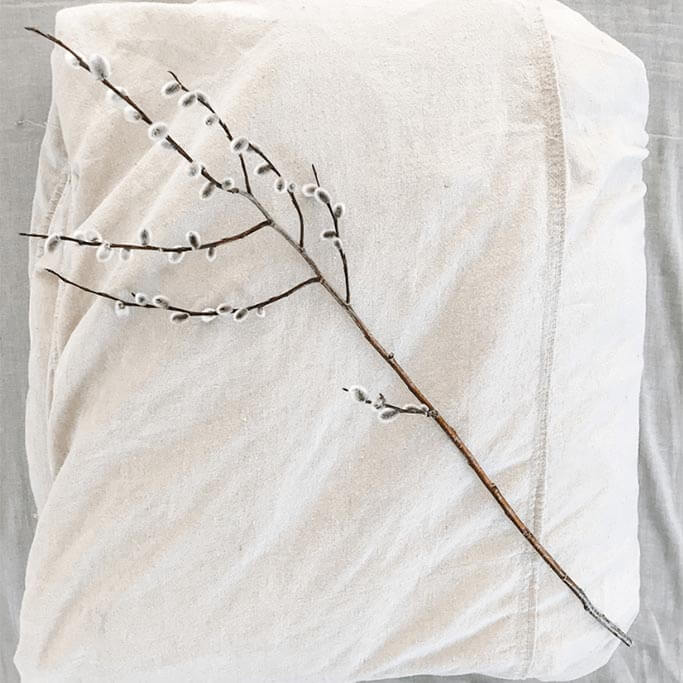
And aside from duvets, if you’re in search of a vegan comforter, sheets – even mattresses, I’ve got you covered.
But first, there’s a dark side to everything – even blankets and pillows. Impossible, you say?
I wish that were true.
Read on to learn more about why you should choose ethical bedding. Then check out some of the many options below!
Because the prices of vegan bedding can vary widely, here is a handy pricing guide to help you choose the best option for you and your budget.
$ = Under $100
$$ = $100-$250
$$$ = $250-$500
$$$$ = $500+
Featured Video
Why You Should Choose Cruelty-Free Vegan Bedding
The three most common types of animal-based bedding are down, silk and wool.
While the down industry claims the majority of down is a by-product of the meat industry (meaning it was plucked from already dead birds), website Care 2 reveals that 50%-80% of down still comes from live birds. Plus, according to Peta, “undercover video footage shows employees on goose farms pulling fistfuls of feathers out of live birds, often causing bloody wounds as the animals shriek in terror.”
Silk bedding is often pitched as an excellent alternative to down duvets due to its hypoallergenic properties. But, according to Earth Divas, the silkworms used in the production of human goods have now been farmed for so long they can no longer exist in the wild. If allowed, a silkworm would follow the natural stages of metamorphosis. However, the majority of silkworms are boiled alive or gassed inside their cocoons before they can further mature.
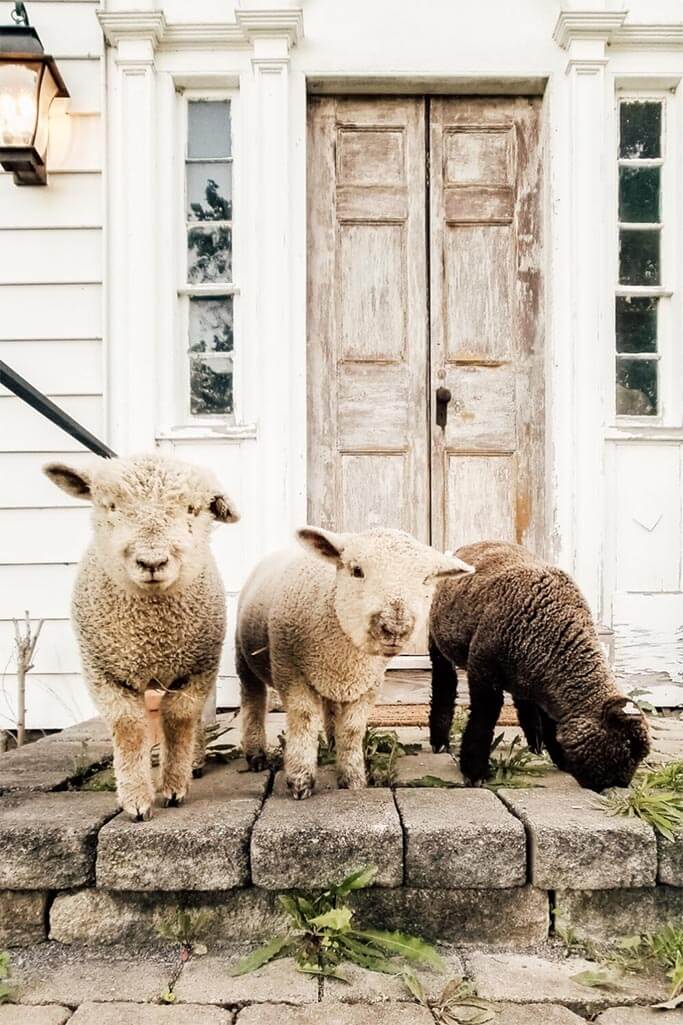
As for sheep, they naturally only produce enough wool to protect themselves from cold weather. But as with so many consumer products today – a high demand meant the development of highly questionable practices to maximize output and profit. As PETA reports, it’s considered “normal” for four percent of lambs to die every spring due to malnutrition.
Need help choosing eco-conscious furniture and decor for your home? That’s what I’m here for!
3 Types of Budget-Friendly Vegan Duvets
Vegan duvets can get expensive, especially if you want one that’s made from natural materials. But all three of the below duvets cost under $100 USD. So no matter which one you choose, you won’t be breaking the bank.
Hombys Lightweight Cooling Viscose from Bamboo Duvet Insert
The duvet filling for bamboo duvets is typically viscose, which is essentially the wood pulp from a bamboo tree, or a similar bamboo-fibre filling. Bamboo is one of the fastest growing plants in the world. Plus, it’s also naturally anti-bacterial, anti-fungal and odour resistant.
Size: Queen (Also available in California King, King, Oversized Queen, Super King, Super King Plus and Twin.)
Price: $
Sunflower 100% Cotton Duvet Insert
100% cotton is another common ethical bedding material. And if you end up purchasing a cotton duvet that is Oeko-Tex certified, even better. Then, you can rest assured beneath a duvet that contains no harmful substances – and was produced in an environmentally friendly manner.
Size: King (Also available in Twin, Full and Queen.)
Price: $
Linenspa All Season Hypoallergenic Down Alternative Duvet
A polyester duvet is an ultra affordable alternative to the often more expensive natural fabrics like bamboo and cotton. Synthetic fabrics often come with their own set of issues (i.e.: formaldehyde is used to keep fabrics wrinkle-free and moisture-resistant). Sometimes you have to weigh the pros against the cons and make the best choice for you!
Size: Queen (Also available in California King, Full, King, Oversized Queen, Oversized King, Twin and Twin XL.)
Price: $
3 Affordable Vegan Comforters for a Cruelty-Free Sleep
Not a duvet person? Not a problem! You can also easily find vegan comforters, which is basically a fancy way of saying a thick blanket. Some people even use the terms duvet and comforter interchangeably. But I prefer to think of a duvet as something you put a cover on, while a comforter is something that doesn’t require a cover.
For vegan comforters, you essentially want to check what the fill is – just like with vegan duvets. Here are a few of my top picks for the most affordable options.
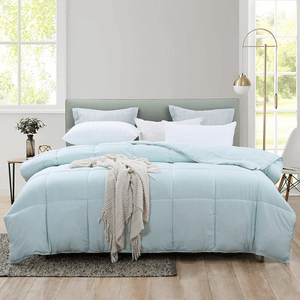 L Lovsoul Bamboo Comforter
L Lovsoul Bamboo Comforter
With a bamboo cover and a combination of bamboo and microfibre for filling, this comforter is cooling to the touch, yet still affordable thanks to its hybrid materials. It’s machine washable so keeping it clean should be a breeze.
Size: Queen (Also available in Twin, King and California King.)
Price: $
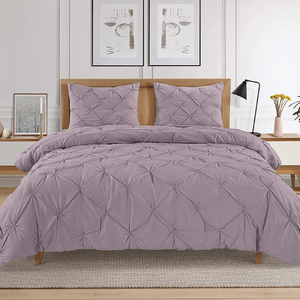 Lane Linen Organic Cotton Comforter Set
Lane Linen Organic Cotton Comforter Set
If you like when your bedding matches, this set comes with the comforter plus two shams. Made from organic cotton with a microfibre filling, you can also get it in colours like Cool Blue, Linen and Mineral.
Size: Full/Queen (Also available in Twin and King.)
Price: $
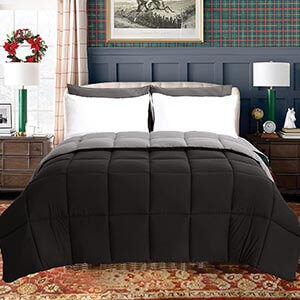 Downcool Reversible Down Alternative Comforter
Downcool Reversible Down Alternative Comforter
Even more affordable than the previous two options, this black and grey reversible comforter is made from polyester. The box stitching helps stop the fill from shifting around and bunching up. Because no one likes a lumpy blanket.
Size: Queen (Also available in Full and King.)
Price: $
6 Vegan Sheets and Duvet Cover Sets
It doesn’t make sense to invest in a cruelty-free, eco-friendly duvet and not pair it with a sustainable cover and sheets. You can buy vegan sheets and covers for your duvet from Amazon and other big retailers. Or you can directly support small eco-friendly bedding brands like Grund and Delilah, or shop at earth-minded marketplaces like Earth Hero and Made Trade.
Casa Platino Organic Cotton Sheet Set
An organic cotton sheet set for less than $100? Now that’s a great deal! Comes with a fitted sheet, flat sheet and two pillowcases. Plain white sheets are a great option for those of us who like to keep things simple.
Size: Queen (Also available in Twin, Double and King.)
Price: $
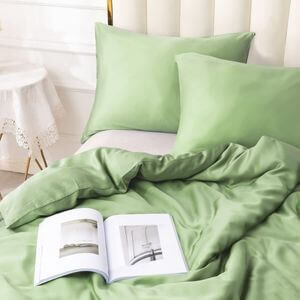 Gokatta Bamboo Duvet Cover Set
Gokatta Bamboo Duvet Cover Set
This set includes a 300 thread count bamboo rayon duvet cover and comes with with two shams in either green, grey, dark grey or blue. Woven with SIRO spinning technology, which makes the fabric smoother and softer compared to traditional ring spun fabric. Cool, hey?
Size: King (Also available in Queen.)
Price: $
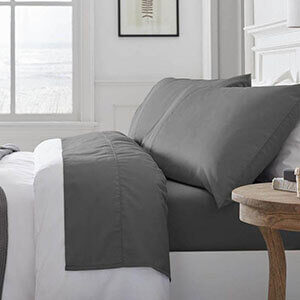 Grund Organic Savannah Bed Sheets
Grund Organic Savannah Bed Sheets
Here we take a jump in price range, but for the additional investment you get a super high quality product from a trusted brand dedicated to “ensuring that conscious consumption is available to all.” Which is just as beautiful of a mission as the beauty of these organic cotton sheets.
Size: Full (Also comes in Twin, Queen and King.)
Price: $$$
Delilah 100% Organic Hemp Bed Sheet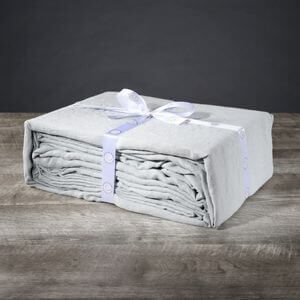
Did somebody say hemp? Indeed! Hemp is actually a very old material that was used for centuries and has only recently become popular again thanks to its eco-friendly properties. Hemp is a lovely material for bedding because it keeps you warm in the winter and cool in the summer.
Size: Queen (Also comes in Twin XL, King, Full and Split King, plus you can get a duvet cover made from the same fabric.)
Price: $$$
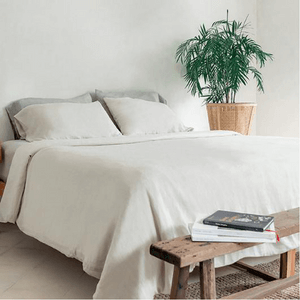 Baloo Linen Sheet Set
Baloo Linen Sheet Set
How’d you like a sheet set that gets softer everytime you wash it? Yes please! In case you didn’t know, linen actually comes from flax and this particular set is made from stonewashed French flax. Ooh… fancy.
Size: Full (Also comes in Queen and King.)
Price: $$$
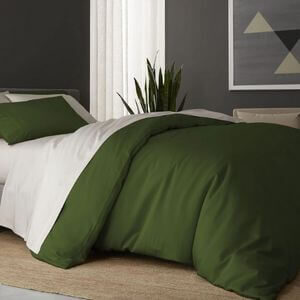 Sijo Tencel Eucalyptus Duvet Cover
Sijo Tencel Eucalyptus Duvet Cover
What’s tencel you say? Great question! It’s a fibre obtained from plant pulp using recyclable solvents. Plus, Sijo, the brand that makes this cover, has so many ethical and eco things going for it there’s no way I could list them all here.
Size: Full/Queen
Price: $$
5 Sustainable Vegan Mattress Brands to Pair with Your Ethical Bedding
If you’re in the market for a new mattress (or pillows!) don’t forget to veganize them too. Here are five brands to whose only dream is for you to have a good sleep.
And since mattresses are – of course – more expensive than other bedding products, I created a separate price guide for this section. A good mattress is an investment – but a worthwhile one!
$ = Under $500
$$ = $500-$1000
$$$ = $1000-$1500
$$$$ = $1500+
Avocado Mattress
The carbon neutral company Avocado has a vegan mattress option made with certified organic cotton instead of wool. Plus, Avocado’s mattresses are made without the use of toxic chemicals or petroleum-based foam. They also have an organic latex and kapok vegan pillow!
Size: Twin (Also comes in Twin XL, Full, Queen, King and California King.)
Price: $$$
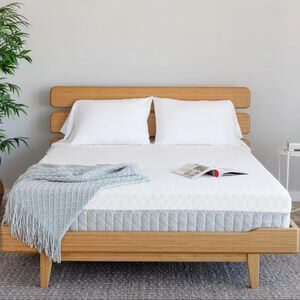 BedInABox
BedInABox
The first company to put a mattress inside a shippable box, BedInABox started a trend back in 2004 that continues to grow in popularity almost twenty years later. They also now offer the Eco-Lux mattress, which is OEKO-TEX Certified, CertiPUR-US Certified and Bio-Preferred Certified. And they have pillows and sheets made from eco-friendly tencel!
Size: Twin XL (Also comes in Queen, King and Split King.)
Price: $$$
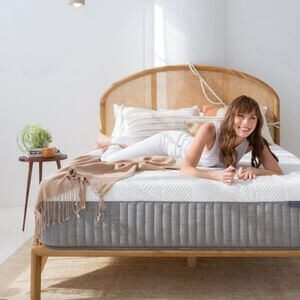 Brentwood Home
Brentwood Home
Brentwood Home’s Cypress mattress is charcoal-infused, CertiPUR-US certified and made from plant-based BioFoam layers. And it’s affordable too! Plus, the company partners with an organization that helps restore kelp forests.
Size: Twin (Also comes in Twin XL, Full, Queen, King and California King.)
Price: $$
Custom Mattress Makers
Got an antique bed that doesn’t fit with modern mattress sizes? (Because I do!) Or maybe you bought a used travel trailer and want to replace the mattress but can’t find anything that works. US-based Custom Mattress Makers can create a cotton and tencel mattress to fit pretty much any situation.
Size: Pretty much any size (or shape) you need!
Price: $$
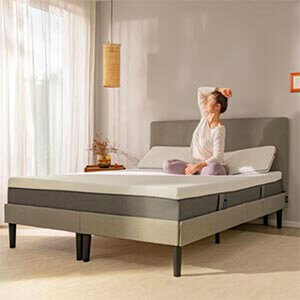 Emma Mattress
Emma Mattress
Another entry into the CertiPUR-US category, meaning it’s made without any ozone-depleting chemicals and is free from formaldehyde and VOCs . If you’re looking for an affordable, yet very well-reviewed vegan mattress, the Emma Original is the number one selling online mattress in the world!
Size: Twin (Also comes in Twin XL, Full, Queen, King and California King.
Price: $$
And finally, don’t forget to check out your local secondhand shop for gently used bedding. Depending on your stance, you might be okay with purchasing something with down, silk or wool duvet filling as long as it isn’t new.
Phew. That was a lot of talk about bedding. I think I’ll go take a nap…
PIN ME!
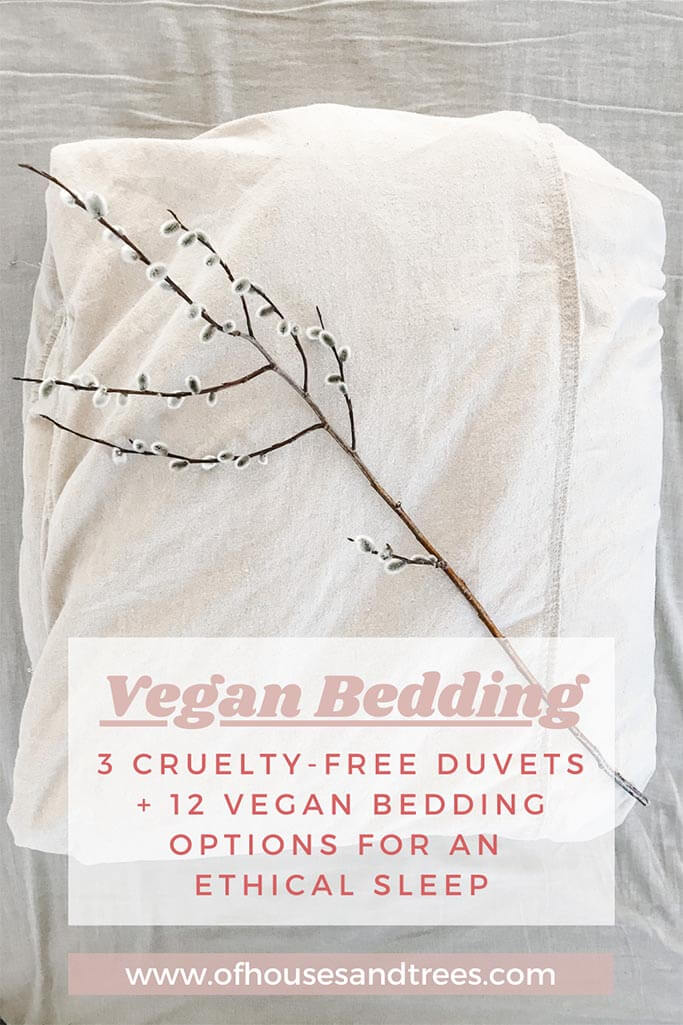
Originally Posted on January 19, 2015 (Last Updated on September 1, 2022)
Need help choosing eco-conscious furniture and decor for your home? That’s what I’m here for!
Former architectural technologist. Current treehugger.
I’m here to help you green your home – and your life.
Subscribe to the Of Houses and Trees monthly newsletter and I’ll send you my FREE list of “The 8 Best Places to Buy Eco-Conscious Decor Online.”
What on earth is sustainable design? Learn all about this eco-focused design method and read the latest posts about green architecture, interior design and decor.
Sustainable living is more than just a thing treehuggers talk about. It’s about making conscious choices everyday. Read the latest posts on living with the planet’s wellbeing always in mind.
Visit the Of Houses and Trees sustainable product directory and support brands trying to make a difference in the world.
Find out more about our 40 acres of land in Parkland County, Alberta and the sustainable home we built amongst the trees.
Need help creating the home of your dreams? Care about the planet? You’ve come to the right place! check out my affordable, sustainable e-design services.
Having a had time choosing paint colours? I’ve got you – and your walls – covered with an interior paint palette sure to compliment your home.
Have questions about creating an eco-conscious home? Go ahead – ask me! Sign up for one of my free online interior design consultations and ask me anything you want.



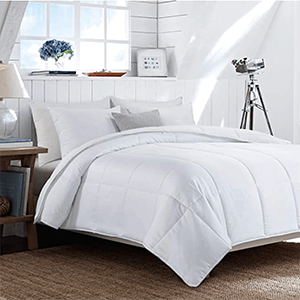

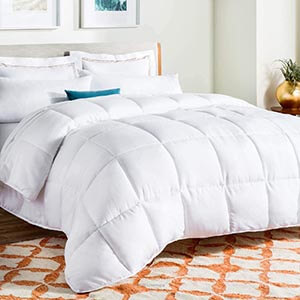
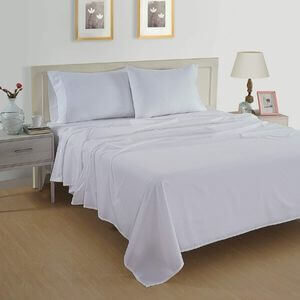
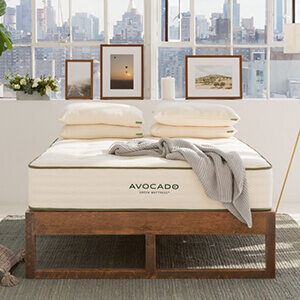
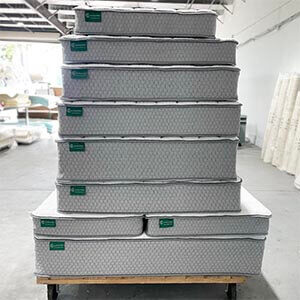



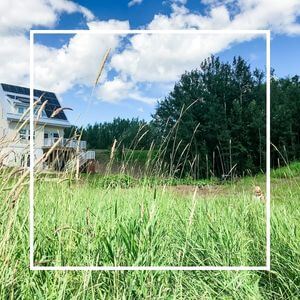
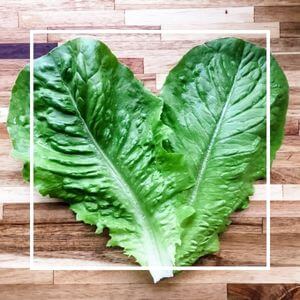
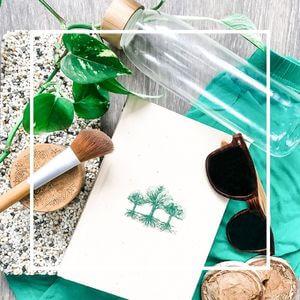
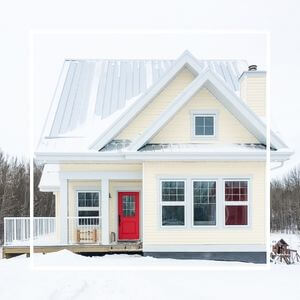


The ethical treatment of the creatures we harvest for food is very important to me. When it comes to using creatures for our goods (duvets, silks, paper, ect.) I even find it to be impractical these days. Almost everything can be made synthetic now, so why brutally tear out goose feathers for bedding… Skin animals for fur… Why?
I also hope silk worms are treated well… And also that we don’t end up learning silk actually comes from genetically modified goats who secrete spider silk.
The thing about synthetics though is that nasty chemicals may be used in the creation process. Also, the companies that make said products may test on the very animals you’re trying to protect by purchasing these so-called “alternatives.” Now I sound like a conspiracy theorist… which I kind of am.
The only earth sustaining product I can think of right now that we own are some toys that are made of recycled materials as well as the little about of packaging it comes in (as opposed to a lot of the toys where the packaging has a million wires, ties, plastic pieces, etc.). I haven’t researched the process of these toys, so I cannot say for sure.
And speaking of bras, some days I don’t even put one on. Nothing more earth sustaining than au naturale!
You always open my eyes with all your facts Larissa!!
Thanks for the comment Leo! Yes – no bra equals saving the world, I totally agree. As for toys – yikes. I fear they are sometimes the worst. Especially, as you say, the packaging. It’s like childproof wrapping on a child’s toy. Crazy.
Poor silk worms, I had no idea of their sad fate:( I may continue to smell my way through the silk garments hanging in the clothing boutiques, old habits are hard to break, but will now, armed with new information, check the label for the harvesting friendly peace silk label.
PS… Are they sure the bamboo doesn’t feel a thing?
I suppose we can’t be sure about the poor bamboo… perhaps we should ask it?
Hmmm an interesting question. I bought bamboo socks the other day and I love them! Does that count? c.
Yes bamboo socks count!
Hi, I hope you don’t mind me asking but did you purchase the microgel duvet from the company whose link you have posted on Amazon and if so, how is it. Does it specify on the duvet that ot is OEKO-Tex Certified?
I don’t mind you asking at all! I got something very similar from a store in my hometown. It’s very lightweight, but still warm. The only thing that bothers me about it is it did end up getting a little lumpy, which is why I was hesitant to get a duvet in the first place. That only impacts the look of it though, not the comfort. The packaging said that it is Oeko-Tex certified, but the tag does not. I hope that helps! Let me know if you have any other questions.
We do not want our bedding or clothing plucked from a duck or goose. We could not live with ourselves knowing we caused crulity to any animal. Is the comforters that say Downs Alternative, actually mean feather free? We have tried to research and are confused.
Thank you for your time in this matter.
Steve & Marti
Hello Steve and Marti and thanks for commenting! Yes, if something is called a “down alternative” that means it was not made using down/feathers and instead was made of another material such as bamboo, cotton or a synthetic fabric.
That being said, always take a look at what the duvet is actually made of either in the description if you’re buying online or on the packaging/tag if you’re buying in a store. For example, you’d want to look for materials such as “100% bamboo,” “100% cotton” or “100% polyester.”
Another option is to look for a duvet at secondhand stores. If you found something that did include goose feathers secondhand, buying it wouldn’t be telling the duvet industry that they need to make more down-filled duvets like it would if you were to buy a brand new down duvet. It’s kind of like buying something leather that is secondhand versus buying something new.
I hope that helps. Let me know if you have any other questions!
I don’t know what country you are from, but here in the UK, secondhand shops, aka charity shops will not take in used duvets.
I have enjoyed reading your interesting article so much I have pinned to my Pinterest for others to read and share.
Thanks Tiffany!
Yes, but whilst microfiber and organic cotton may be cruelty free, isn’t it true that they are not ecologically sound? I have not heard of the micro gel option, but that sounds like manmade plastics to me. Surely the only ecological and cruelty free option is the bamboo? Please enlighten me if I am wrong? I spent all day yesterday researching this, unfortunately bamboo duvets are wildly overpriced, I don’t know why they cost so much, when, as you say, bamboo is the world’s fastest growing grass plant.. I’ve found a double, all bamboo duvet for £65 on eBay, it even has the Oeko-tex label on it, but I’m suspicious of the product as it is half the price of a, ‘Panda Cloud’ duvet which is 50% bamboo and 50% nano microfiber! As the saying goes, ” if something is too good too be true, it probably is,’ what do you think? I am thinking of waiting until this years Black Friday event to see if I can get a reduced Bamboo duvet, but if I wait, I’ll miss out on the seemingly impossible ebay bargain, as they have only 20 left to sell? I’m on a fixed budget, so it’s a real quandary!
Boy! I’ve just read that the majority of bamboo is processed chemically, and the majority is manufactured in China, so most supposed eco-friendly bamboo products is false, it’s just as bad as producing cotton! Only mechanically produced bamboo is echo friendly, but it is labour intensive, and I guess that’s why the right kind of bamboo fabric and duvet filling is so expensive! And even with the mechanically produced bamboo fabric, you have to consider the milk are it takes to transport it. Apparently Sweden produces some, but only a fraction of the world’s production! It is a mine field out there! So basically if you are buying bamboo fabrics, you should ask if it has been mechanically or chemically produced. There is some hope, I am now going to investigate linen fabric made from flax or hemp! I still am no wiser on which duvet to purchase?
I ment miles it takes to transport bamboo, not milk! Should have checked before posting!
All very good and thoughtful observations! Unfortunately in the realm of sustainability, there isn’t always a clear answer. But the fact that you have been looking into it so deeply is truly inspiring. If everyone took the time to consider how what they purchase impacts the environment the world would be a different place. I’ve seen bedsheets made of hemp. They’re very pricey as well, but the truth is that inexpensive things are usually priced that way for a reason – because of material and production shortcuts and labor issues. Let me know if you find a linen or hemp duvet and I’ll add it to my post.
Great post!
Thank you!